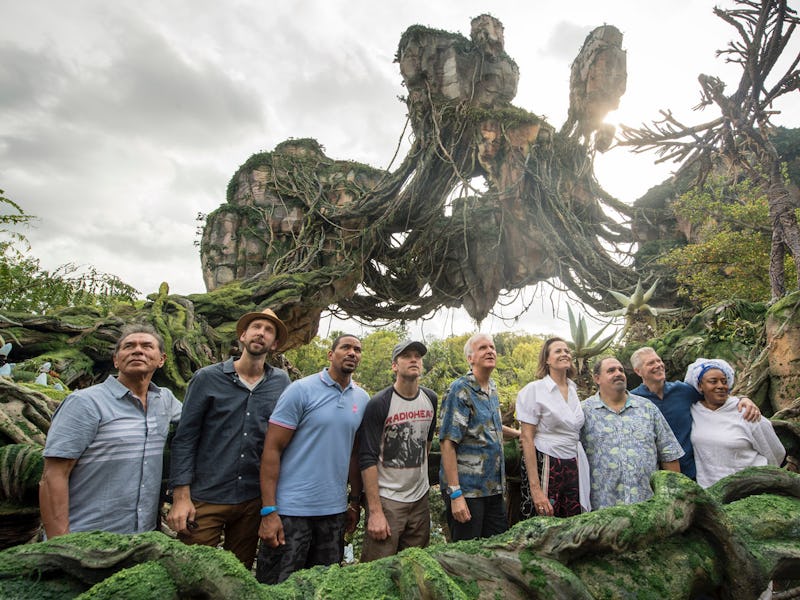Why Disney's Avatar Park Focuses on a New Story
"It’s not about what happens in the movie. The focus is on being immersed in Pandora itself."

Disney’s new theme park “Pandora — The World of Avatar” may be inspired by James Cameron’s 2009 blockbuster, but the people who designed the new park emphasize the fact that it exists on its own terms, independent of the film.
“It is not about the movie, not about the plot, it’s about going to Pandora,” Mark LaVine, the Disney Imagineer who served as lead writer and head of story on the project, told Inverse on Wednesday.
LaVine was one of several Imagineers to make that point in interviews during a preview day for the new park, which is located inside Disney World’s Animal Kingdom. (Full disclosure: Disney hosted scores of journalists, including myself, sponsoring our trips to Orlando to check out the new park ahead of its Saturday opening. We maintain editorial independence in what we publish).
Instead, the story of the theme park is set about “a generation or so” after the events of the first movie. The decision to fast-forward and veer away from the characters and conflict in the Oscar-winning film was a necessary and obvious one, for several reasons. Disney’s Animal Kingdom emphasizes environmentalism, so its “Pandora” park was built to emphasize the natural splendor of a world that Cameron first imagined when he was 19 years old; much the movie deals with a battle over the colonialist exploitation and destruction of that land, making for a conflict that would clash with the goals of the park.
“If it’s about going to Pandora, then it’s not really about Neytiri and Jake and the characters in the movie,” LaVine explained. “If we want this idea that nature is extreme, then all the conflicts of the RDA have to be behind us. They’re gone. They were destructive, so they’re gone, and now their camp is left. And we want you to go as an ecotourist to a place that is really almost like a national park on an alien world.”
A sign at the entrance to Pandora for the Mo'ara Valley.
With a somewhat fresh slate, the Imagineers, in close collaboration with Cameron’s Lightstorm Entertainment, went to work developing a new generation of details for the park — which will stand apart from the sequels that Cameron is directing for the big screen.
“He’s making more movies, and we don’t know where those are going, as far as plot or time period, so we decided we wanted to steer clear of that,” LaVine said. “We created new organizations, a whole new line of storytelling, and new characters who won’t be part of the plots of any movies.”
Cameron was incredibly hands-on during the design and creation of the park and helped channel the Animal Kingdom’s guiding ethos — transformation by experiencing nature — into a new branch of the overall Avatar world. In the same way that Disney created a new fictional space travel company and droids for its Star Wars ride “Star Tours,” it invented new organizations and institutions to help along the story in the Pandora park, which is set in a place called the Valley of Mo’ara.
The filmmaker spent years fleshing out the world of Pandora for the film, creating an entire race of people — the Na’vi — and populating the lands with lush vegetation and animals. Imagineers created even more backstory, to help set up and support the new storyline, and also supplemented Cameron’s original vision for Pandora.
“It was filling in the gaps and elaborating,” Lisa Girolami, the executive producer for the entire project, told Inverse. “When you go to a three-dimensional world, in a movie you’re telling a story and taking people on a journey; here we set people loose and say go wherever you want, and study what you want, and experience what you want. So we have to add a lot more. So there are some animals, some flora, that are new. They weren’t in the original movie, but it’s all in keeping with the Avatar vocabulary.”
Keen observers and frequent visitors will notice that they feature all stages of the alien fauna’s lifecycle throughout the park, as well as a daily cycle of animal calls. They may be fictional creatures and organisms — there are plants called things like Puffball Tree, Dapophet, Vein Pod, and Scorpion Thistle — but their development and presentation were treated like they were real.
Floating mountains at Disney's Pandora
The Imagineers at the helm spent about four-and-a-half years working on the project, which opens over seven years after the movie made over $1 billion at the global box office. With delayed sequels not scheduled to begin hitting theaters until 2020, it was paramount to create an experience that could exist on its own, whether the movie franchise was in or out of the spotlight. Having seen the movie is not necessary to understanding the park.
“The way we approach the storytelling is we want you to not have to remember the film, or if you’ve never seen it, we’re going to give you what you need to know,” LaVine explained. “If you do know the movie, then it’s going to be very rich in all the things you want to see.”